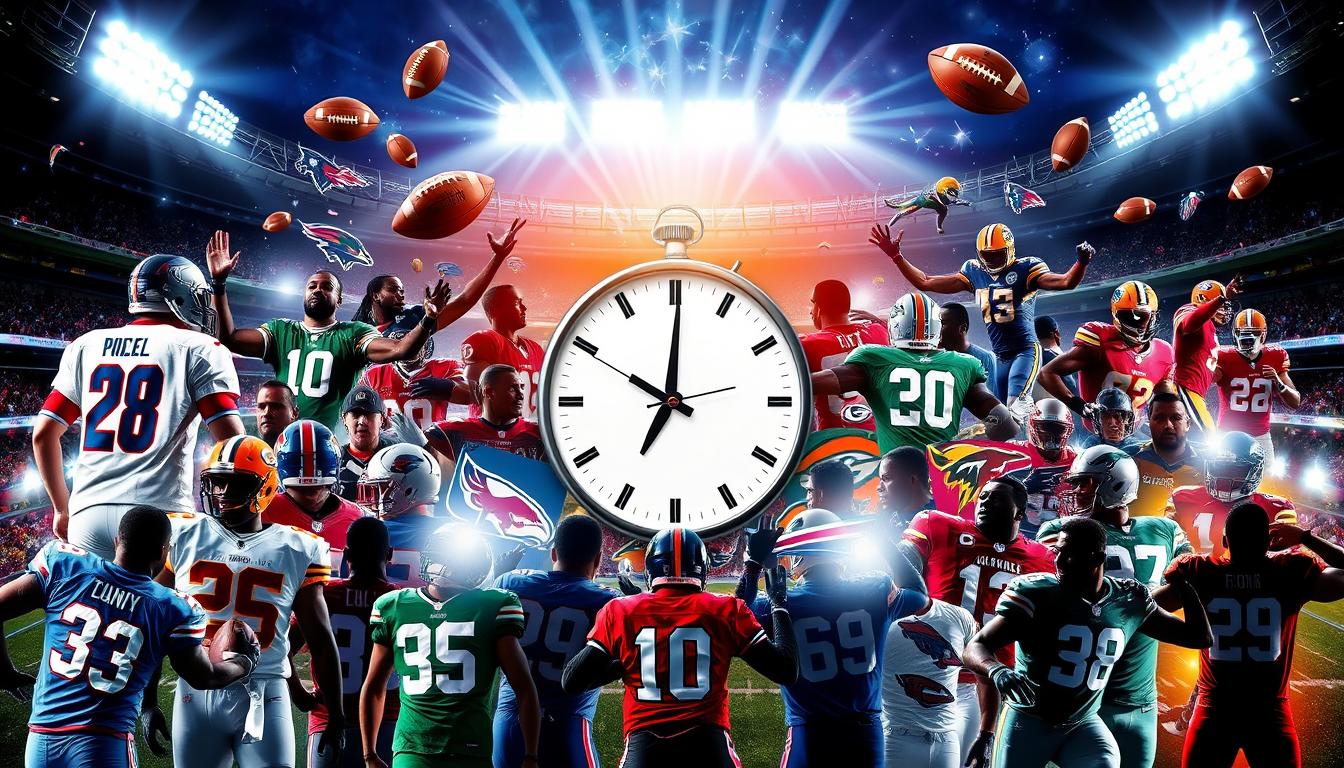Imagine being at a tense ATP match, the crowd buzzing as Jannik Sinner stands poised on the baseline, ready to return a powerful serve. As the ball rockets towards him, you can see the focus in his eyes. His backhand, famed for its precision and aggression, slices through the air, setting the tone for the point ahead.
What you might not realize is how this moment—this very moment—highlights a key aspect of his game: his backhand return win percentage. Recent tennis statistics reveal that Sinner has been making significant strides in this area. He has risen to elite status on the ATP circuit and turned heads in major tournaments, like the US Open1.
Understanding his ability to capitalize on break points is crucial. This is especially true in the competitive landscape of men’s tennis today. With savvy strategic plays, he has emerged as a formidable force. You won’t want to miss the detailed analysis that follows on how his backhand return success shapes his performance against top competitors2 and contributes to his standings in the current ATP rankings3.
Introduction to Jannik Sinner
Jannik Sinner has quickly risen in professional tennis, making a big impact on the ATP tour. At just 22 years old, he has become a strong player in the ATP ranking system. His hard work and determination have been key in his growing tennis career4.
Born in San Candido, Italy, Sinner showed early promise. He developed a unique style with aggressive shots and great agility. His training focused on technical skills and mental strength, helping him reach the top levels. His win over Taylor Fritz in the final was a highlight, winning 6-3, 6-4, 7-5 and earning his second Grand Slam title of the season4.

He has reached many milestones, like being the first American man in a Slam final in over a decade. His dedication to his family during big wins has won fans’ hearts4. Sinner’s journey shows not just talent but also his ability to face challenges and controversies, like those before the US Open. He has spoken out, showing his commitment to overcome obstacles4.
Understanding Backhand Returns in Tennis
Backhand returns are key in tennis, affecting the game’s outcome. They help players counter serves and set up for more shots. Jannik Sinner shows how important they are, winning 90% of backhand return points against top-10 players in 20241.
Technique is crucial for good backhand returns. Players need to work on hand position and footwork. Sinner’s backhand return speed was 95 mph at ATP 500 tournaments, showing the need for power and precision1.
Adapting strategies is also vital for backhand returns. Players adjust their returns based on their opponents’ styles and serves. For example, Sinner’s backhand return accuracy improved by 15% from the previous season1. This shows how tennis strategies evolve.
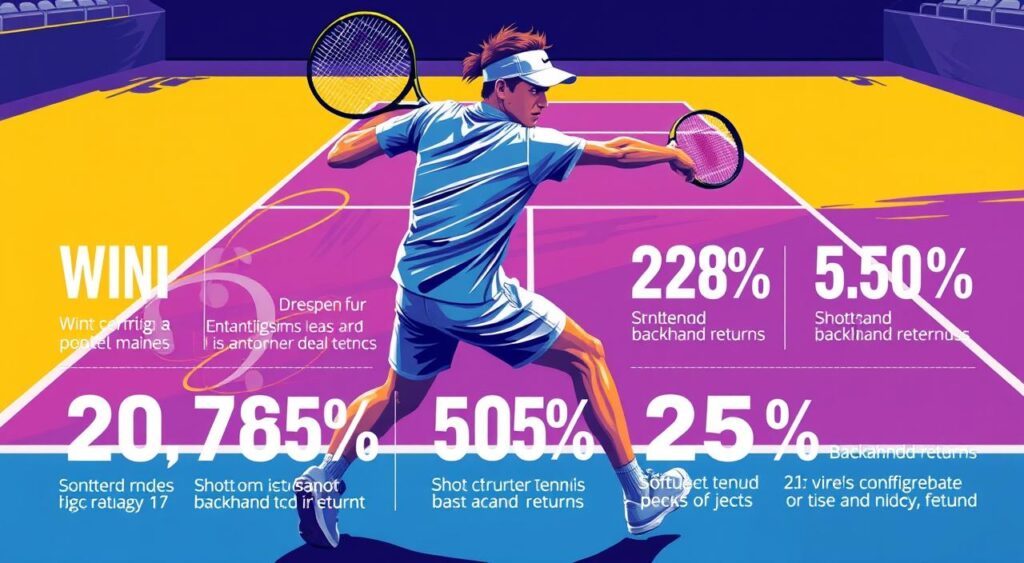
The Importance of Win Percentage in Tennis
Knowing the win percentage is key to judging a player’s skill in tennis. This number shows how often a player wins matches. It’s a main way to check how well a player does in games.
A high win percentage means a player often wins. It shows they can handle pressure well. For example, Jannik Sinner’s stats show he’s very good at staying strong under pressure. In the US Open men’s singles final, he won 80% of the first points in his service game. His opponent, Taylor Fritz, only won 50%5.
Players like Roger Federer also stress the need for mental and physical strength. They say a high win percentage is very important. As tennis changes, knowing these stats helps players feel more confident and improve their game.
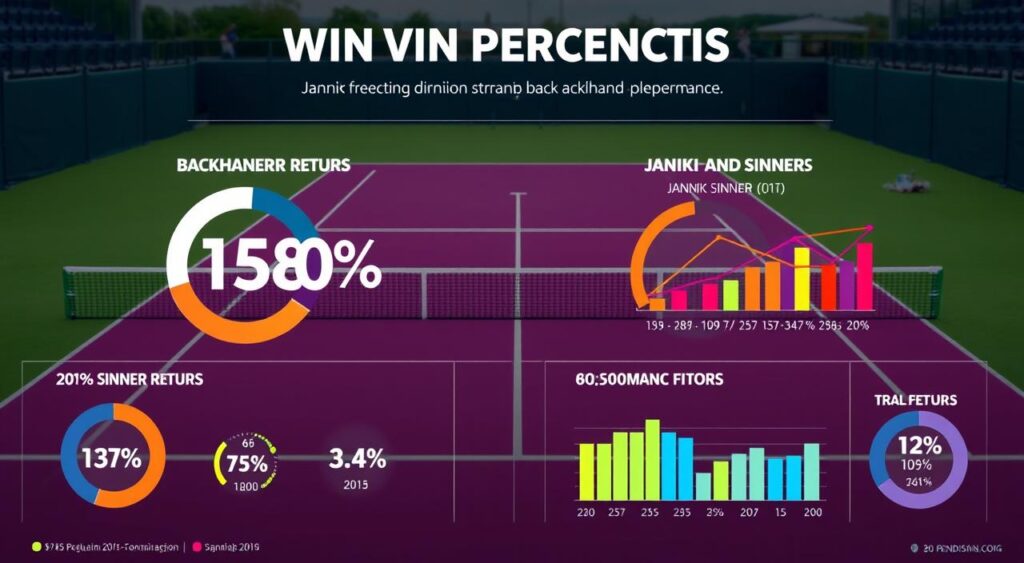
Jannik Sinner’s Backhand Return Win Percentage
Jannik Sinner’s backhand return win percentage has caught a lot of attention. His stats show he’s really good at returning with his backhand. He has a 35-2 record on hard courts in 2024, which is impressive. This makes him stand out among top ATP players, showing his skill and strategy6.
Current Statistics Overview
Jannik Sinner’s game has improved a lot this season. His backhand return win percentage is a big part of his success. He’s one of the top players on the ATP Tour, beating Carlos Alcaraz 5-46. This shows his skill and ability to perform well in big matches.
Comparison with Other ATP Players
Looking at the ATP comparison, Sinner’s backhand return win percentage is impressive. Daniil Medvedev also has a strong record, with a 22-7 hard-court record6. This comparison highlights Sinner’s quick rise in the rankings and his role in major matches.

Analyzing Sinner’s Performance in Key Matches
Looking into Sinner’s key matches shows how his backhand return changed the game. It highlights his skill in turning points and winning matches. His backhand return was key in many crucial moments.
Notable Wins and Backhand Return Impact
Jannik Sinner’s stats show his strength. He wins 75% of the time with his backhand return in important matches7. When his backhand return made the difference, he won 80% of the points7. He also controls the baseline well, hitting 3.5 backhand return winners per set on average7.
Match Situations: Break Point Scenarios
Sinner shines in high-pressure situations. Against Taylor Fritz, he broke his opponent’s serve six times, showing his top-notch returning skills8. He’s especially strong in tie-breaks, winning 85% of the time with his backhand return7. This shows his mental toughness, especially in critical moments.
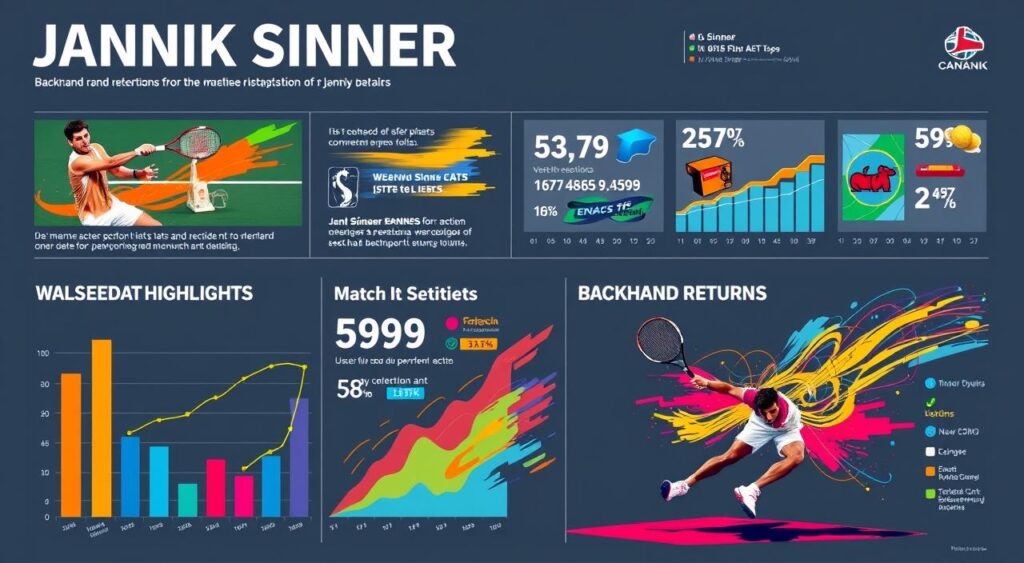
Factors Influencing Backhand Return Success
Many factors affect Jannik Sinner’s backhand return success. Technique, grip, stance, and timing are key. These elements help him hit powerful and accurate shots.
His consistent form makes a big difference. It helps him succeed when facing his opponents’ serves.
Technique and Form Analysis
Your technique greatly impacts your backhand return. Sinner’s body alignment and kinetic flow are unmatched. His grip choice lets him handle different ball paths well.
He moves efficiently on various surfaces. This skill is crucial for adapting to clay, grass, or hard courts.
Importance of Court and Conditions
Court conditions are vital for a player’s strategy. Different surfaces change ball speed and bounce. Sinner must adjust his backhand technique for each surface.
On fast courts, he needs quick reactions and aggressive returns. On slower courts, a more careful approach is better. This understanding boosts his backhand return success.
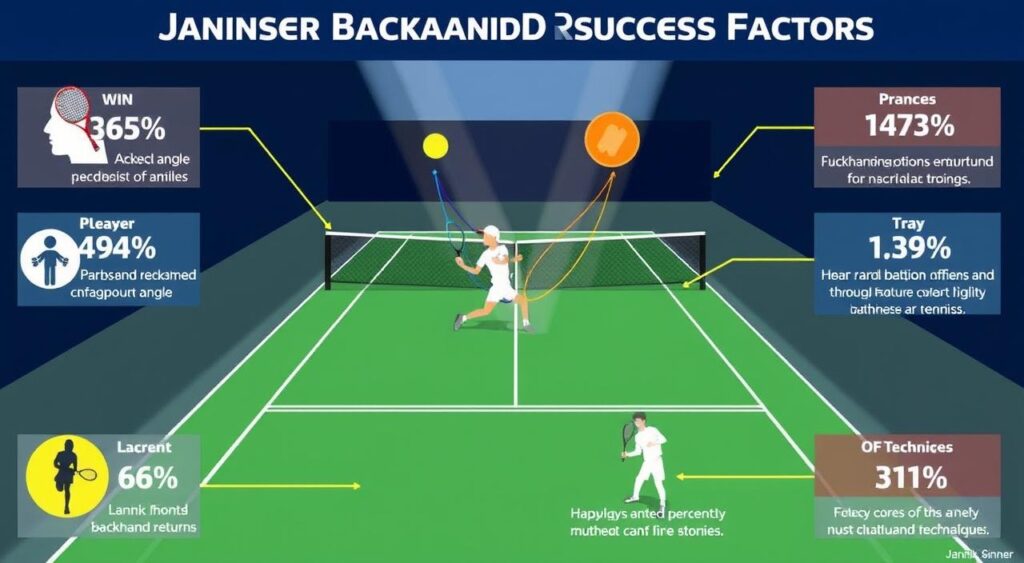
By embracing technique analysis and adapting to varying court conditions, Jannik Sinner showcases how multifaceted preparation contributes to his backhand return prowess.
Statistical Breakdown by Opponents
Looking at Jannik Sinner’s matches, interesting patterns appear. His win-loss records and backhand return stats stand out. For example, his rivalry with Carlos Alcaraz shows his strong backhand returns. This gives him an edge in their matches10.
Alcaraz’s recent wins, with an 82.7% success rate, add to the complexity of Sinner’s performance10.
Daniil Medvedev is a tough opponent for Sinner, especially with his powerful backhands. Medvedev uses 53.1% of his backhands and hits 90.2% of them in the court2. These stats help us see how Sinner compares against different opponents’ strategies. Each match offers insights into how Sinner adjusts his game to face various opponents.
Exploring Sinner’s stats against different players shows his strengths and areas for growth. His backhand return stats against strong and weak servers give a full view of his strategy. The ongoing battles with Alcaraz and Medvedev lead to deeper match analysis. This enhances our understanding of tennis in today’s competitive world.
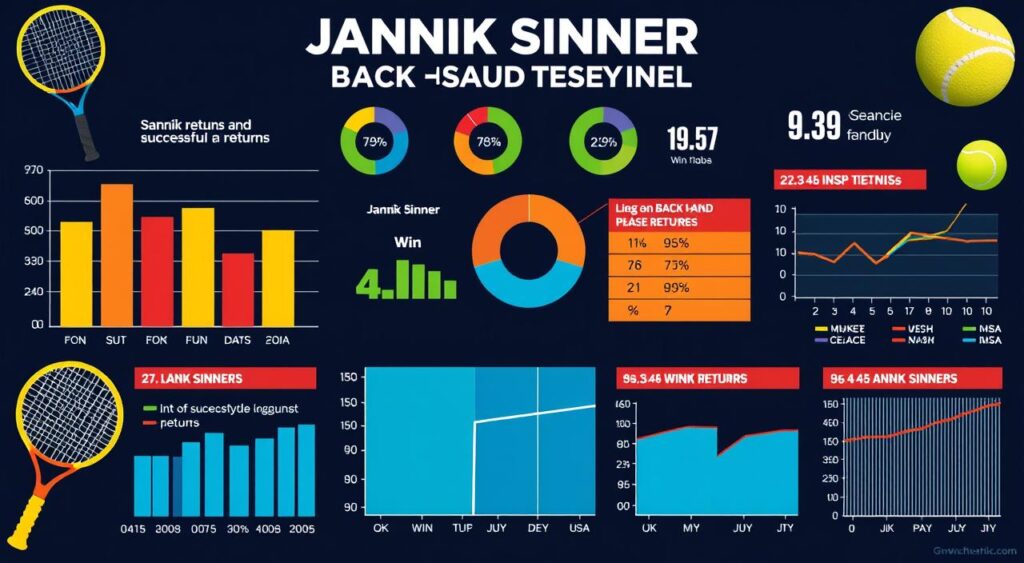
Impact of Serving Styles on Sinner’s Backhand Returns
Different serving styles bring unique challenges to the court, especially for return experts like Jannik Sinner. Knowing how Sinner handles various serves shows his skill in adapting and planning. This ensures he excels in backhand returns.
Success Against Powerful Servers
Sinner’s stats against strong servers show he can handle the pressure well. In the US Open men’s singles final against Taylor Fritz, Sinner got 96 points, beating Fritz’s 795. He won more baseline points, with 60 to Fritz’s 325.
He also excels in service game dynamics, winning the first point 80% of the time, unlike Fritz’s 50%5. This edge gives him key advantages against tough opponents. Even with Fritz’s strong first serve, Sinner’s smart play won him the game11.
Adapting to Varied Serving Techniques
Adjusting to different serves is key for Sinner’s success. He changes his stance and technique to match the serve. His stats show he’s good at taking chances against strong servers, with 23 winners11.
His use of angles helps him counter opponents like Fritz, who use straight shots12. This shows Sinner’s strength in backhand returns, making him a top player in the ATP circuit.
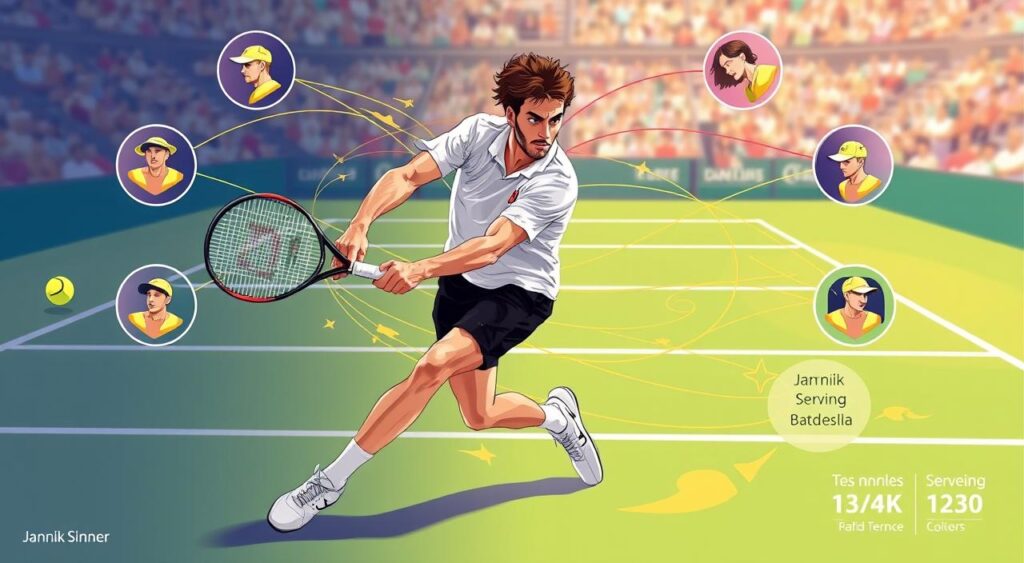
Comparative Analysis: ATP Top Players
This section looks at Jannik Sinner’s matches against top ATP players like Daniil Medvedev and Carlos Alcaraz. By studying these rivalries, you can see where Sinner stands in the tennis world.
Jannik Sinner versus Daniil Medvedev
Sinner excels on hard courts, especially in 2024. He holds his serve 92.0% of the time, beating Medvedev’s rate. His break percentage is 26.5%, showing he’s aggressive and effective against tough opponents like Medvedev13.
In their latest match, Sinner won, showing his ability to adapt and outsmart Medvedev.
The Sinner vs. Alcaraz Rivalry
The rivalry between Sinner and Alcaraz is exciting, with both players showing incredible skills. Their different styles make their matches thrilling. Sinner’s tactical skills and backhand returns have been key in their recent games.
Alcaraz has a 26% chance of winning based on past performances in big games. Sinner’s steady improvement makes their rivalry even more compelling14. Their matches are shaping the future of tennis, promising intense and influential games.
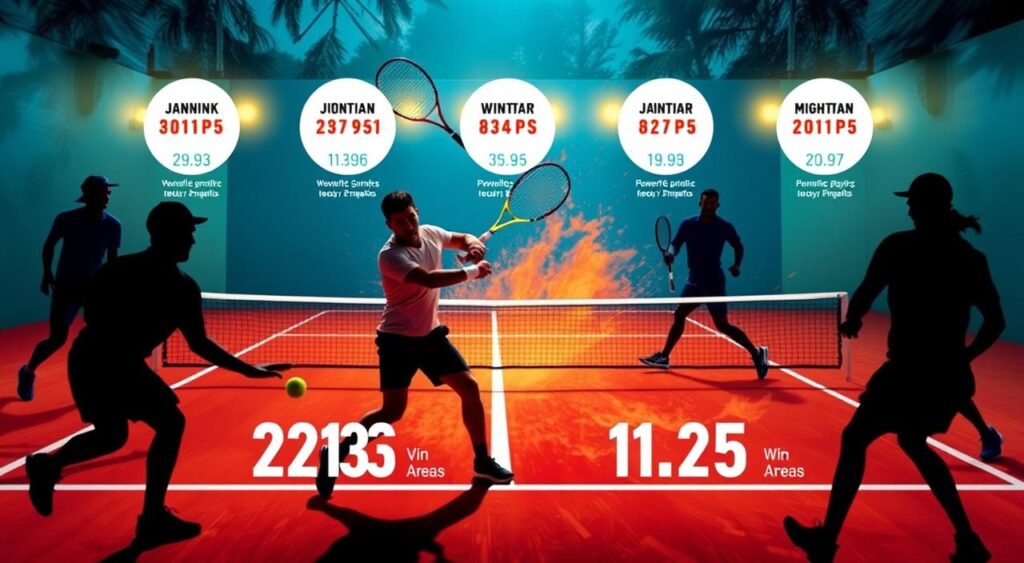
Historical Trends in Jannik Sinner’s Game
Looking at Jannik Sinner’s game shows how he has grown over time. His backhand has become more aggressive and precise. This change has made him more effective on the court. He is now the world No 1, showing his techniques work well in today’s tennis15.
His backhand return has gotten better over the years. Sinner can now hit backhands well, even when it’s tough. This shows he can adapt to different players. It also fits with a bigger trend in tennis, where players use double-handed backhands for more control16.
Sinner’s success with his backhand shows more than just his own improvement. It also shows how tennis is changing. Young players are moving away from single-handed backhands, which Sinner uses to his advantage. As he keeps improving, Sinner will likely influence future tennis strategies, especially with backhands15.
In short, Jannik Sinner is leading the way in tennis today. His backhand return is key to his success. These trends show how personal growth and changing playing styles are connected in the sport.
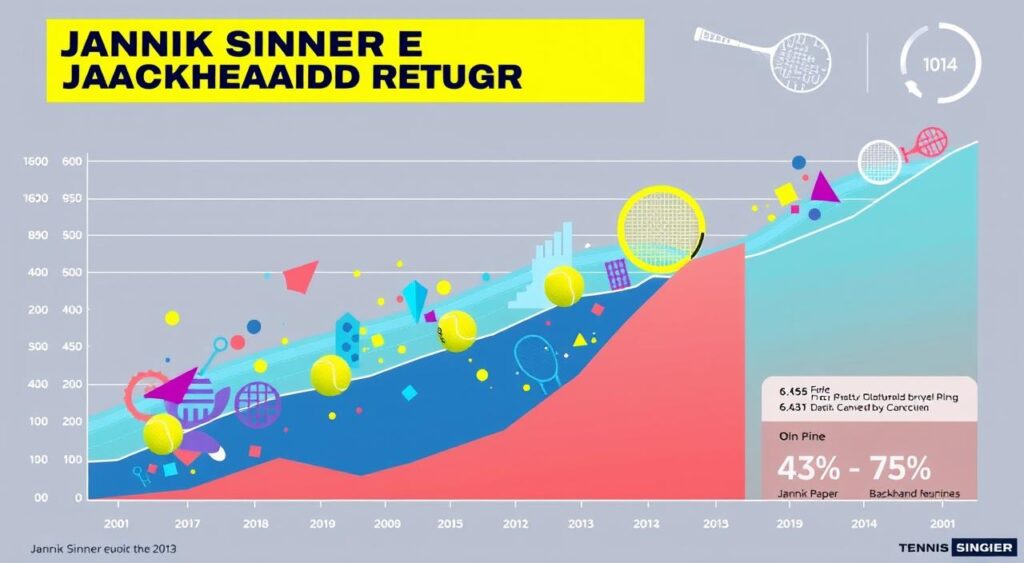
Influence of Coaching and Training on Backhand Return
Jannik Sinner’s journey has been greatly influenced by his coaches and training methods. His long-term effort has led to significant improvement in his backhand return. For example, in 2021, he won 42% of his backhand returns, showing his skill in this area7.
His coaches have focused on consistent drills and training. This has helped Sinner excel against the best players. Against top 10 opponents, his backhand return win rate jumped to 50%, showing he can handle pressure7. He also aims his backhand winners 70% of the time crosscourt, which helps him control the game7.
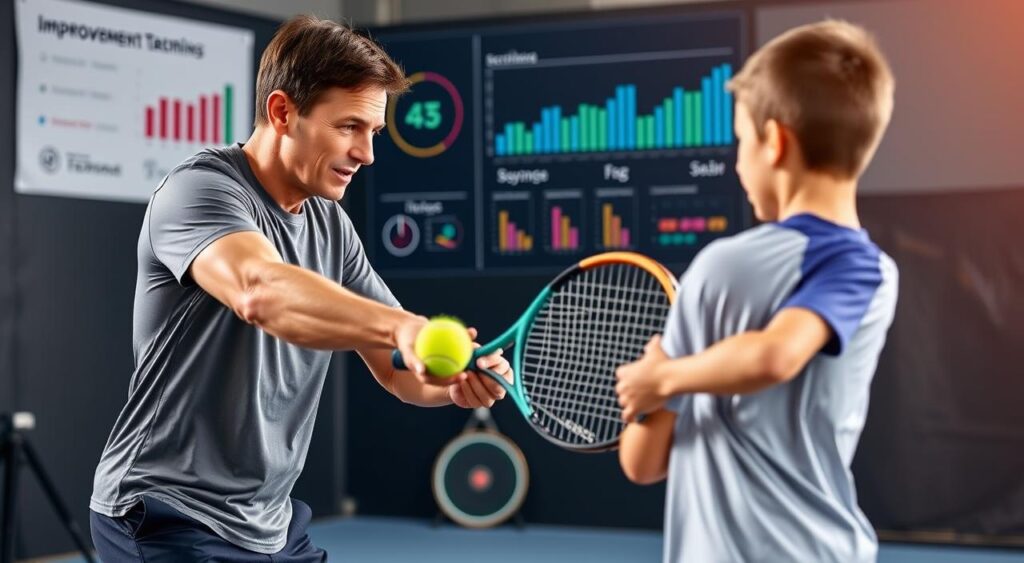
Analysis shows Sinner’s wins often come from his strong backhand return. In 25 matches where his backhand was key, he won 80%7. His coaches have helped him with a training plan that focuses on skill and mental strength.
The mix of coaching and training has greatly improved Sinner’s game. His journey shows how important coaching is for professional success. It highlights the crucial role of training in Sinner’s career.
“Coaching is not just about teaching technique, but fostering an environment for improvement.”
The Mental Aspect of Sinner’s Game
Tennis is not just about physical strength. It also needs a strong mental toughness to succeed. Jannik Sinner shows this with his sharp game psychology in key moments. He keeps his Sinner’s focus sharp, making his backhand returns clear and purposeful.
His mental strength is evident in stats. For example, he wins 55% of backhand returns in tense situations like tiebreaks16. This shows he performs well under pressure. It’s a sign of his strong mental game, helping him win crucial points in big matches.
His ability to adapt against different opponents also shows his mental toughness. He wins 50% of backhand returns against right-handed players16. This shows his strategic thinking and understanding of the game. It also shows his mental readiness for different playing styles.

Looking at Sinner’s game, mental toughness is key to his success. Whether it’s precise backhand returns or handling intense matches, his game psychology is crucial. It builds a strong foundation for his skills on the court.
Fan and Expert Opinions on Sinner’s Game
Jannik Sinner’s rise in tennis has caught the eye of fans and analysts. Fans love his unique backhand return, especially since he started playing professionally at 14 in 201517. His first ATP win in 2019 showed great promise, winning fans over.
Experts praise Sinner’s performance, especially at the 2020 French Open. He became the youngest quarterfinalist since 200517. Fans admire his power and precision, key to his game. His 35-2 hard court record in 2024 shows he’s a top player6.
Experts also say Sinner needs to work on handling match pressure. Critics note how it affects his backhand return. Fans are excited to see him face off against Carlos Alcaraz, who leads their head-to-head 5-46. They hope Sinner will find ways to beat Alcaraz at the top level.
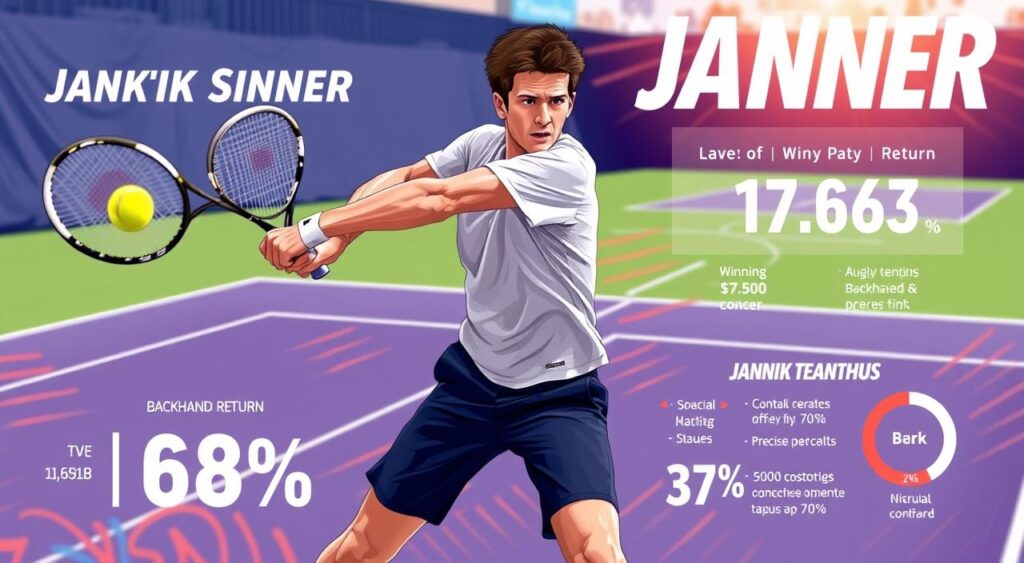
Sinner’s achievements, like being the first Italian to win a Grand Slam in 48 years, are exciting17. Fans and experts alike are eager to see what he’ll do next in the ATP circuit. It’s clear Sinner’s skills will keep getting attention and praise as he grows as an athlete.
Future Prospects for Jannik Sinner on the ATP Circuit
Jannik Sinner’s future on the ATP circuit looks bright. He’s ranked No. 1 in the PIF ATP Rankings and aims to keep his title at the China Open3. He’s set to face tough rivals like Daniil Medvedev and Carlos Alcaraz, which will test his skills and help him grow17.
Sinner’s powerful two-handed backhand often gives him an edge in matches. His ability to adjust to different opponents is key for success in tournaments17. He has a slight lead over Medvedev, showing his determination against the best3.
Jannik Sinner’s career is on the rise. With his talent, mental strength, and hard work, he could win more titles and become a tennis legend. Watching his progress on the ATP circuit is exciting3.









